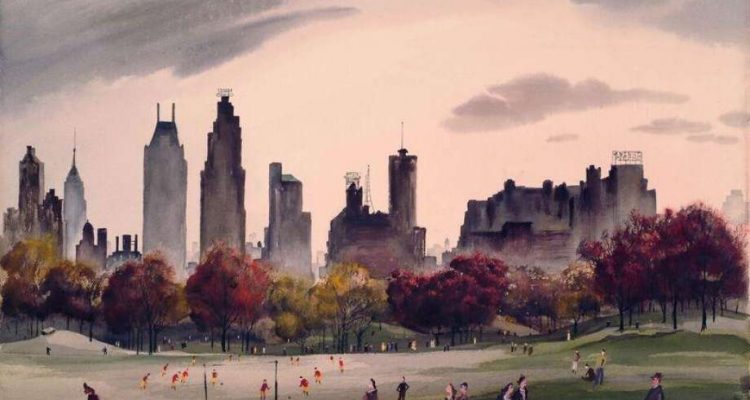“Take me back to Manhattan, take me back to New York” — a famous lyric from the 1934 musical “Anything Goes” — is the first thing that comes to mind upon viewing the works of artist Adolf Dehn (1895-1968). Dehn was a mid-century artist known for his captivating paintings, lithographs (a type of print) and drawings of iconic New York sceneries. And, as the song suggests, New York’s unique atmosphere is what makes the city so adored.
Dehn’s striking pieces are highlighted in the exhibition entitled “Adolf Dehn: Midcentury Manhattan,” which is on display at the Fairfield University Art Museum in Bellarmine Hall. Dr. Philip Eliasoph, an art history and visual culture professor at Fairfield, is the guest curator for the exhibition who has dedicated a great portion of his career to researching Dehn. This infatuation with the artist led Eliasoph to write an up-and-coming book, also entitled “Adolf Dehn: Midcentury Manhattan,” that discusses Dehn’s work and will be published by The Artist Book Foundation.
“In ‘Adolf Dehn: Midcentury Manhattan,’ I argue that stylistic transformations in American art simply left Dehn by the wayside,” said Eliasoph. “The world changed, and by the late 1940s into the 1950s, the art world progressed into abstract and expressionist work.”
Eliasoph explained that the present skyline of New York, 75 years following Dehn’s work, showcases an abundance of buildings and new skyscrapers. Eliasoph’s personal love of New York — as he once knew it — is an additional aspect that drove him to resurface Dehn’s art. This quality is something that did not go unnoticed by observers.
“The most interesting part of the exhibit is how all of his works were kind of rediscovered by a professor at our school,” said Haley Pilkington ‘19. “All of the works are very close to where we are and are based off of New York and the city skyline. The fact that we didn’t know that these existed or how popular they once were is very fascinating.”
Beauty never goes out of style, and that proved to be true at the exhibit’s opening reception on Jan. 26 where, according to Fairfield University’s snapchat, over 300 people gathered to observe 28 of Dehn’s pieces. The extreme attention to detail and harmonious weaving of paint left viewers in awe.
“I came here tonight for a watercolor class that I have to take for the core [curriculum],” explained Davis Doherty ‘19. “I don’t usually come to these sort of events because I’m an engineer, but as I was looking around at all of the different pieces, I noticed that Dehn does an amazing job at blending different colors together and utilizing different wash techniques.”
Doherty’s observation that Dehn harnesses multiple artistic techniques is evident. His work shows signs of applying paint to one section and then scraping it away to apply a different, overlapping color. There are places where paint is built up and there are other places that show thin scratching gestures. These diverse techniques make Dehn’s work appealing to the observer, whether or not they’re an art aficionado.
The first thing one might notice upon entering the gallery is the variety of different media forms on display. There are watercolor and gouache (opaque watercolor) paintings, ink washes, charcoal drawings and — Dehn’s main attraction — lithography work. By incorporating numerous types of Dehn’s pieces, the exhibition enthralled observers and holds something new to look at on each wall and around each corner.
Another intriguing quality to Dehn’s work can be found in some of the figures represented in his paintings. The people shown are almost caricature-like in the sense that they have evident human characteristics while also having playful, disproportionate qualities. For example, most of the people painted by Dehn have interestingly skinny legs that slightly come to a point or disappear into the landscape. As a social realist artist, this aspect adds a unique and fascinating quality to his pieces due to the fact that social realism is an art form that aims to draw attention to everyday conditions and pays close attention to critical detail. According to “The Art Story: modern art insight,” social realist artists thrived during the 1930s — a time of economic downfall and racial conflict — because they created pictures of large groups of people which highlighted the lifestyle of the middle class. Eliasoph holds a clear adoration for Dehn’s work and is excited for the resurfacing of the widely unknown artist.
“The works coming into focus here, unfettered by a politically charged agenda and critical myopia, allow us renewed pleasure from Dehn’s artistry,” said Eliasoph.
Because the lively city became his home, Dehn’s work truly encompasses all aspects of mid-century Manhattan. His passion for the city is demonstrated in the exhibition due to the vast variety of locations represented. Some major scenes include the “Brooklyn Waterfront,” “Lower Manhattan,” “New York Harbor,” “New York Skyline,” and many different representations of Central Park. The exhibition fully engrossed the stimulating vibe of midcentury New York and the inspiring dedication Dehn emulated.
The exhibition will be on display in Fairfield’s Bellarmine Museum from Jan. 27 until April 7.


Leave a Reply